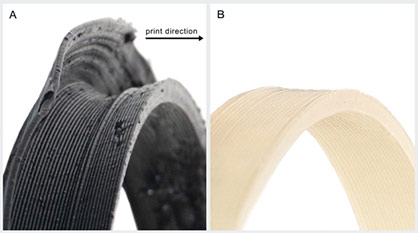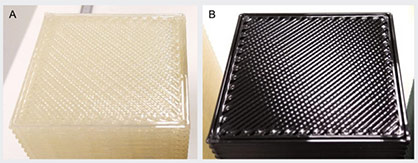#Additive Manufacturing
Ingeo 3D700 provides significant reduction in warping and minimizes print failures
These properties make Ingeo well-suited for 3D printing using many different types of printers and for a broad range of printing applications from consumer-level to industrial applications.
Testing by NatureWorks’ global partners demonstrates a shrink rate less than 0.25% in printed parts and obtainable lower print temperatures due to optimized melt viscosity & microstructure
In large-format printing, the higher rate and volume of polymer deposition can quickly result in excessive warpage with certain materials, like ABS, or significant shrinkage as with some polyolefins or even some general-purpose PLA grades. This can result in failed prints as warping pulls the part away from the print bed or causes layer separation. With the longer print times and higher-volume material use in industrial applications, failure during production is costly. By controlling the polymer-microstructure, the resulting amorphous PLA grade, Ingeo 3D700, has a low material shrink rate which is critical for reducing warpage, improving gap fill and adhesion, and ensuring successful prints.
“As the 3D printing space expands into larger, more complex applications, we are seeing an increased need for printing materials that are tailored for a specific application or process,” says Dan Sawyer, Business Development Leader for NatureWorks. “With significant growth in large-format additive manufacturing for industrial applications, we saw the opportunity to develop a new Ingeo biopolymer grade specifically designed to minimize the loss of time and material due to failures in large format prints.”
A common approach for minimizing part warpage in large prints is to use compounded materials with reinforcement such as mineral fillers, glass, carbon, or cellulosic fiber. Because Ingeo 3D700 has been designed for low shrinkage, there is an opportunity to use less reinforcing product and still achieve quality large-format parts, while maintaining the reliable printability of Ingeo PLA. If a specialty print requires additional reinforcement, then cellulose-based additives are easily compounded with Ingeo 3D700 creating a biobased compound alternative to high-cost petrochemical-based compounds such as carbon-fiber ABS.
Partner Testing Results
Multiple partners evaluated Ingeo 3D700 for use in large-format fused filament fabrication (FFF) and direct resin-to-print processes with positive results.
“In our testing, we found that Ingeo 3D700 goes one step further towards reducing warpage in large-format prints beyond previous Ingeo PLA grades designed for 3D printing,” said Xiaofan Luo, President at Polymaker, a leading manufacturer of 3D printing material and filament. In addition to lower shrinkage, Polymaker also measured improved z-layer adhesion when printing with Ingeo 3D700.
Dyze Design, an extruder designer and supplier of components for large-format printers, ran print tests comparing Ingeo 3D850, a grade already known for its low-shrink characteristics, and Ingeo 3D700. “Our tests showed that a large-format part printed using Ingeo 3D850 demonstrated a shrink rate of 1.25%. In comparison, the same part printed with Ingeo 3D700 had a shrink rate of less than 0.25%,” said Philippe Carrier, CTO at Dyze. “Because Ingeo 3D700 also has a higher throughput rate, we were able to successfully print at the lower temperature of 190ºC without seeing shrinkage or warping in the part.”

Filament manufacturer, MCPP, conducted printing tests using filament made from Ingeo 3D700 and demonstrated a 11-13% increase in flow rate due to the optimized melt viscosity, compared to a general-purpose PLA. According to MCPP, “this resulted in improved gap fill and adhesion between perimeter layers. Therefore, it is also expected to be suitable for FGF (fused granular fabrication) 3D printing.”

The new Ingeo 3D700 grade is already finding use in metal casting manufacturing. Using a direct resin-to-print process, Shanghai TuoZhuo is printing sand casting molds that can be as tall as 1-2 meters. The 3D printed molds are replacing traditional wood foundry molds because they are faster to produce, more cost efficient, and easier to maintain as wood molds warp over time due to moisture. “There is no warping or deformation when printing with an amorphous PLA grade like Ingeo 3D700,” said Gabino Chen, Project Manager at Shanghai TuoZhuo New Materials Technology Co., Ltd. “Using ABS, PETG, or PA in prints of this size is difficult, which is why it’s important to use PLA and useful to have a PLA grade specifically designed for large format printing.”
Ingeo 3D700 is now available for use as resin pellets for direct resin-to-print processes or as filament for FFF process in the United States, Asia, and Europe. For more information, contact NatureWorks at:
http://natureworksllc.com.













